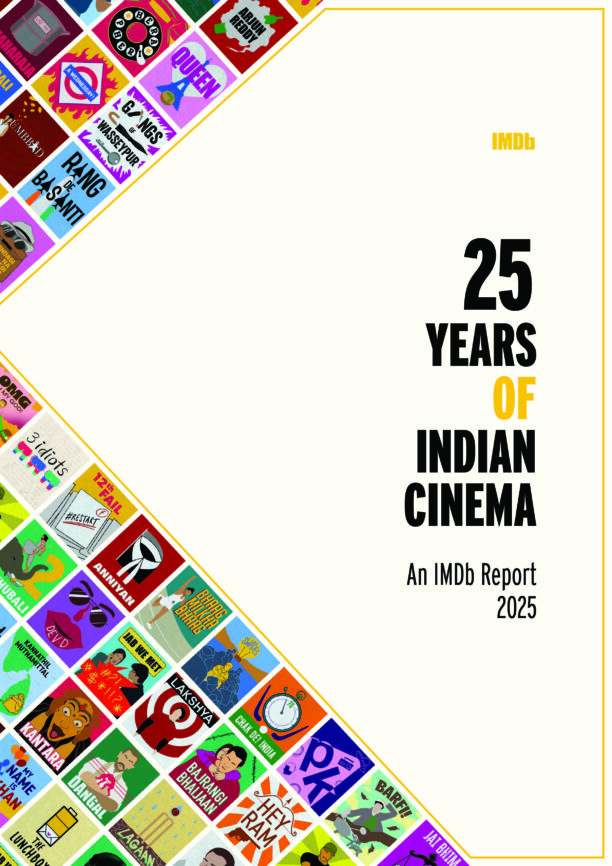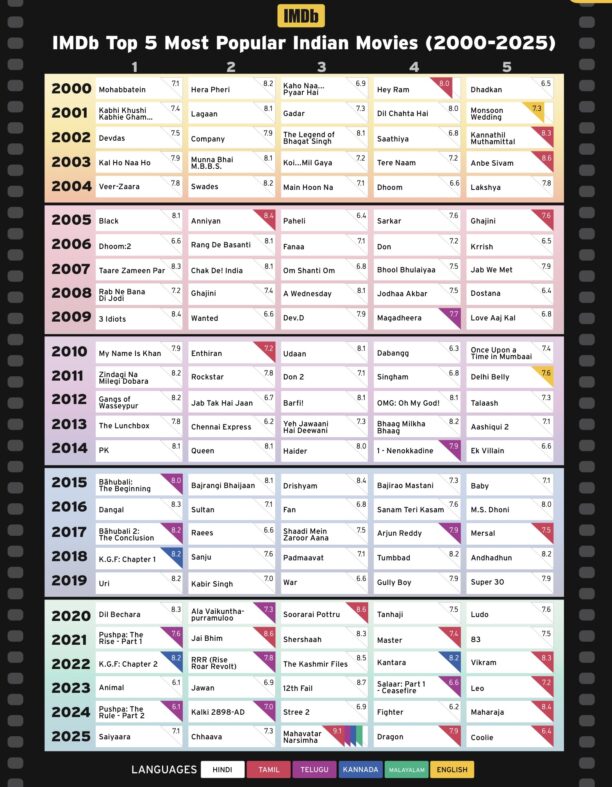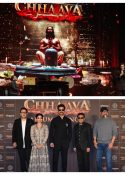 IMDb (www.imdb.com), the world’s most popular and authoritative source for information on movies, TV shows, and celebrities, released a report, titled 25 Years of Indian Cinema (2000-2025), featuring a comprehensive analysis of the Indian film industry’s evolution over the past quarter century. This analysis is based on IMDb data from over 250 million monthly users worldwide.
IMDb (www.imdb.com), the world’s most popular and authoritative source for information on movies, TV shows, and celebrities, released a report, titled 25 Years of Indian Cinema (2000-2025), featuring a comprehensive analysis of the Indian film industry’s evolution over the past quarter century. This analysis is based on IMDb data from over 250 million monthly users worldwide.
The report examines the top five most popular Indian movies released each year between January 1, 2000, and August 31, 2025. These 130 movies collectively account for more than 9.1 million IMDb user ratings, an average of over 70,000 per movie, providing a unique, longitudinal view of global audience interest across languages, formats, and release models.
“The Indian film industry has always been cyclical, so this quarter century mark is a good vantage point to look forward and see what that evolution means for stories and storytellers in the years ahead,” said Yaminie Patodia, Head, IMDb India. “IMDb data offers a singular, global proxy for audience engagement, one that is neutral to platform, geography, and release window. This moment marks a coming of age for Indian cinema — one that embraces a richer tapestry of voices from across industries, driven by collaborations and diverse narrative styles. We are immensely proud to showcase Indian cinema’s representation across the world and look forward to its excellence being celebrated on screens globally.”
Key Findings From the Report
The Mass Movie Is Reclaiming Its Space and India’s Audience Is Seeking Stories in Which They Feel Seen
The report reveals a shift in audience preferences, with the mass movie reclaiming its space. This trend is exemplified by 12th Fail (2023), which stands out as the only movie by a Hindi filmmaker to break into the top 10 most popular Indian movies in Southern states in the last five years. This is a clear indication that, across regions, it’s the movies that resonate with a wider audience that are proving successful.
Collaborations Are Driving Scale; Directors Are Serving as the Key Architects of This New Era of Cinema
The report highlights how cross-industry collaborations are being used as a means for audience expansion. Twelve out of the 25 most popular movies from the past five years analysed in the report feature substantial cross-industry collaboration across direction, casting, music, and distribution. Directors like Lokesh Kanagaraj and S.S. Rajamouli, with four titles each in the report, are leading the charge in making movies that transcend regional boundaries.
The Star-Fan Dynamic Is Changing
The analysis also underscores an evolution in star-fan dynamics. While established stars like Shah Rukh Khan maintain significant influence, appearing in 20 of the top 130 movies across 25 years in the report, stars today are finding success through more strategic project selection and digital presence. They function more as multipliers of a film’s inherent strengths rather than guaranteed box office draws.
India’s Leading Women Are Self-Authoring Their Stardom Deepika Padukone, who debuted in 2007, leads with 10 movies in our dataset, the fourth-highest overall, a density of hits that few stars of her era have matched. Priyanka Chopra Jonas follows with six movies, though her filmography is weighted toward the earlier half of the timeline, reflecting her transition into global projects.
Language Is No Longer a Barrier, It’s a Genre
The report decodes how different language industries have developed distinct narrative identities: Telugu and Kannada films excel in spectacle-driven entertainment, Malayalam cinema in grounded realism, and Tamil films in balancing social themes with commercial appeal. This has led audiences to use language as a reliable indicator of storytelling style, choosing films based on their preferred narrative approach rather than viewing language as a barrier.
A Movie’s Enduring Impact Reflects The Ability To Sustain Relevance Over Time
Traditionally, India’s theatrical culture, built around family-centric viewing, has favoured “something-for-everyone” blends of romance, comedy, drama, and action. But the lens of long-term value allows us to appreciate the demand for genre-specific movies that may underperform theatrically yet flourish over time. Sanam Teri Kasam (2016) and Tumbbad (2018) are notable examples — initially overlooked, they steadily built loyal followings that were strong enough to trigger re-releases. Thrillers like Drishyam (2015) and Andhadhun (2018) thrive on word of mouth by fans of the genre, sustaining discovery long after release. The Lunchbox (2013) and PK (2014) showcase how universal themes can carry Indian movies to global audiences, where they continue to circulate and resonate. At the top of the dataset sits Gangs of Wasseypur (2012), which has acquired cult status over the years for its pathbreaking storytelling style and subsequent fame of its actors.

The above graph, IMDb Top 5 Most Popular Indian Movies (2000-2025) dataset is based on all-time global page views from more than 250 million monthly visitors to IMDb worldwide. It includes movies released between January 1, 2000 and August 31, 2025. All analysis in this report is based on these 130 movies, five from each year.
Other fascinating findings from the report include:
In the first five years of the millennium (2000 to 2004), Shah Rukh Khan’s movies ranked No. 1 each year. Of the 25 films during this period, he starred in eight. Shah Rukh Khan appears in 20 of the top 130 movies across the past 25 years, reflecting both the breadth and the longevity of his career. Even when he does not have a movie release, he remains a fixture in the IMDb Popular Indian Celebrities list, which highlights trending actors and filmmakers every week. In 2024, he appeared in the Top 10 of the list every single week of the year, underscoring a level of star power that few can match.
Hrithik Roshan and Aamir Khan are tied with 11 movies each out of the 130 analysed in the report, followed by Deepika Padukone with 10, Ajay Devgn with seven, and Amitabh Bachchan, Priyanka Chopra Jonas, and Rani Mukerji with six movies each.
Aamir Khan (Dangal, PK, Taare Zameen Par, and 3 Idiots) dominates the segment of ‘Crossover Hits’ of Indian cinema that have high popularity with global audiences and have journeyed far beyond the usual countries for Indian movies.
3 Idiots is the most popular Indian movie worldwide on IMDb, with 468,000 IMDb user ratings, and 8.4 aggregate rating.
Directors Lokesh Kanagaraj, S.S. Rajamouli, Sanjay Leela Bhansali, Rajkumar Hirani, and Farhan Akhtar have each delivered four successful hits in the last 25 years in the report’s dataset.
RRR is the most popular Indian movie of all time in the U.S., whereas 3 Idiots holds that position in the UK, the rest of Europe, and Australia. Dangal is the most popular Indian movie in the UAE and China, K.G.F: Chapter 2 in Pakistan, Baahubali 2: The Conclusion in Singapore, and Taare Zameen Par in Brazil.
Yaminie Patodia said in closing, “Indian cinema stands at a pivotal point as we approach the end of 2025, marking the first quarter of the 21st century. The film industry has always been cyclical, so it is a good vantage point to look forward and see what that evolution means for stories and storytellers in the years ahead.”








